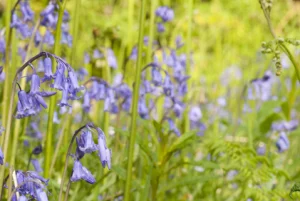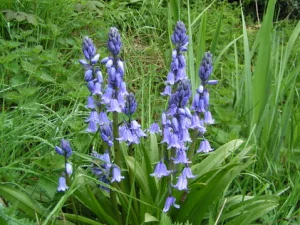Bluebells, Spanish or Native
The Spanish Bluebell is commonly grown in our gardens. It is more vigorous than our native bluebell and can crossbreed with the native to create a fertile hybrid.
This is a problem, as crossbreeding dilutes the unique characteristics of our native Bluebell.
Noticeable differences between the two are:
Native bluebells…

- narrow leaves, usually about 1cm or 1.5cm (about half an inch) wide
- deep blue (sometimes white, rarely pink), narrow, tube-like flowers, with the very tips curled right back
- flowers mostly on one side of the stem only, and distinctly drooping, or nodding, at the top
- a distinct, sweetish scent
- Inside the flowers, the anthers with the pollen are usually cream.
Spanish bluebells…

- broad leaves often 3cm (over an inch) wide
- paler blue (quite often pink and white ones too), conical or bell-shaped flowers that have spread-out tips
- flowers all round the upright stem
- almost no scent.
Inside the flowers, the anthers with the pollen are usually blue (although this may vary a little).
Hybrids between these two are very common, with a whole range of intermediate characters. The hybrids are often abundant in gardens and in woods near to urban areas.
Acknowledgement to Plantlife: The Wild Plant Conservation Charity website ‘What is the difference between native and Spanish bluebells?’. Copyright Plantlife 2022.
You can also read about the differences on The Wildlife Trusts webpage ‘How to tell the difference between a native and a Spanish bluebell’.




 St Wistan’s Pilgrimage Walk
St Wistan’s Pilgrimage Walk

